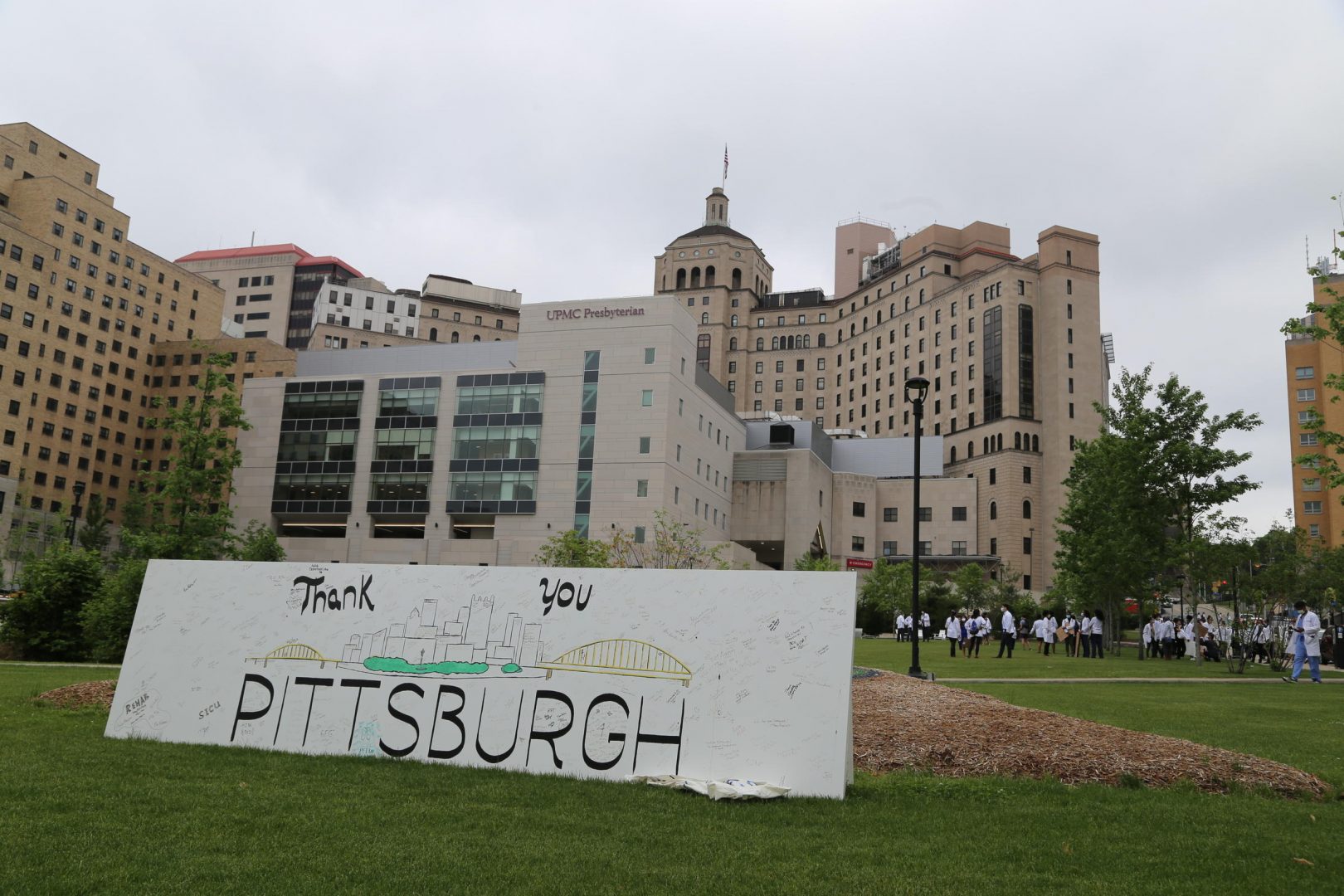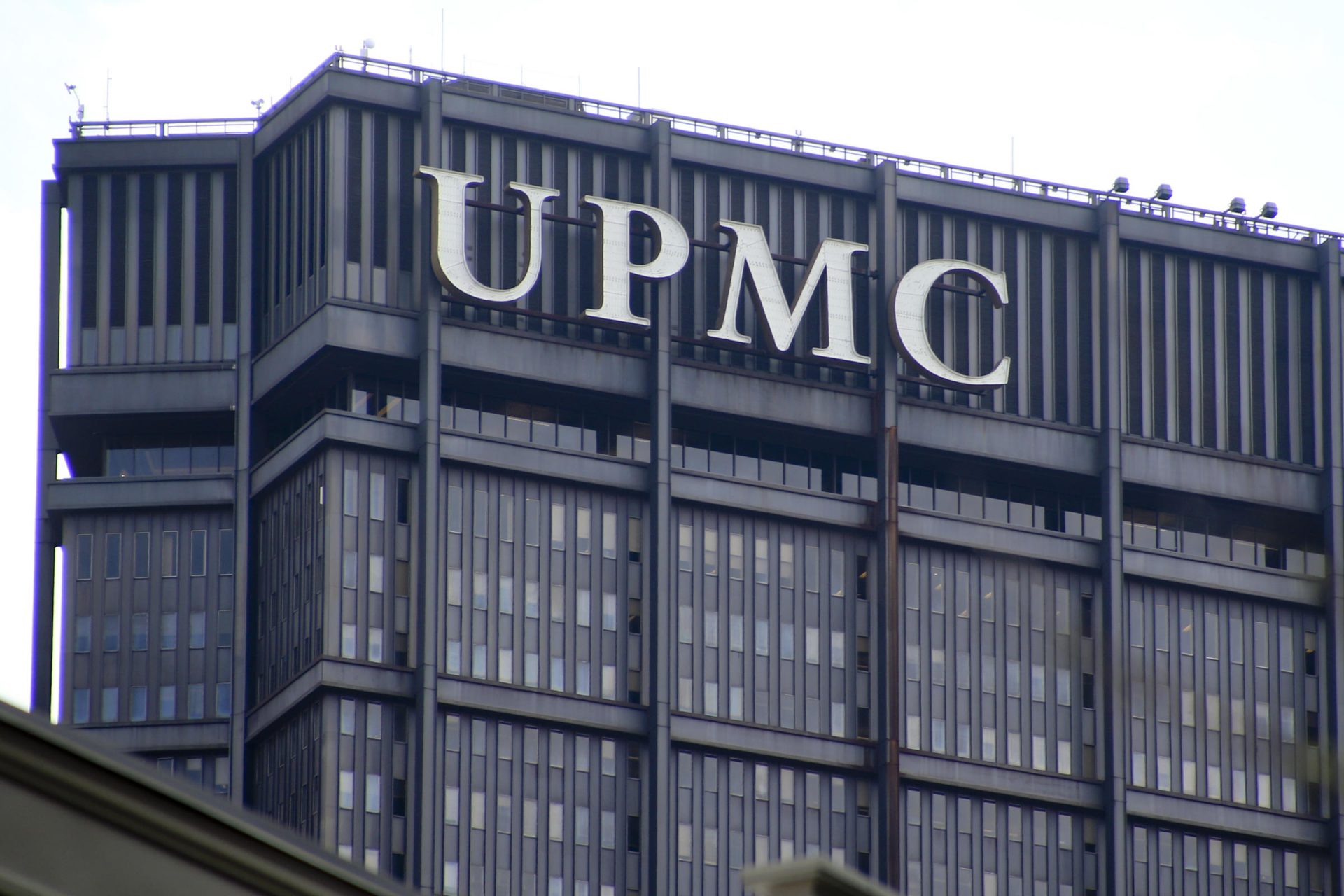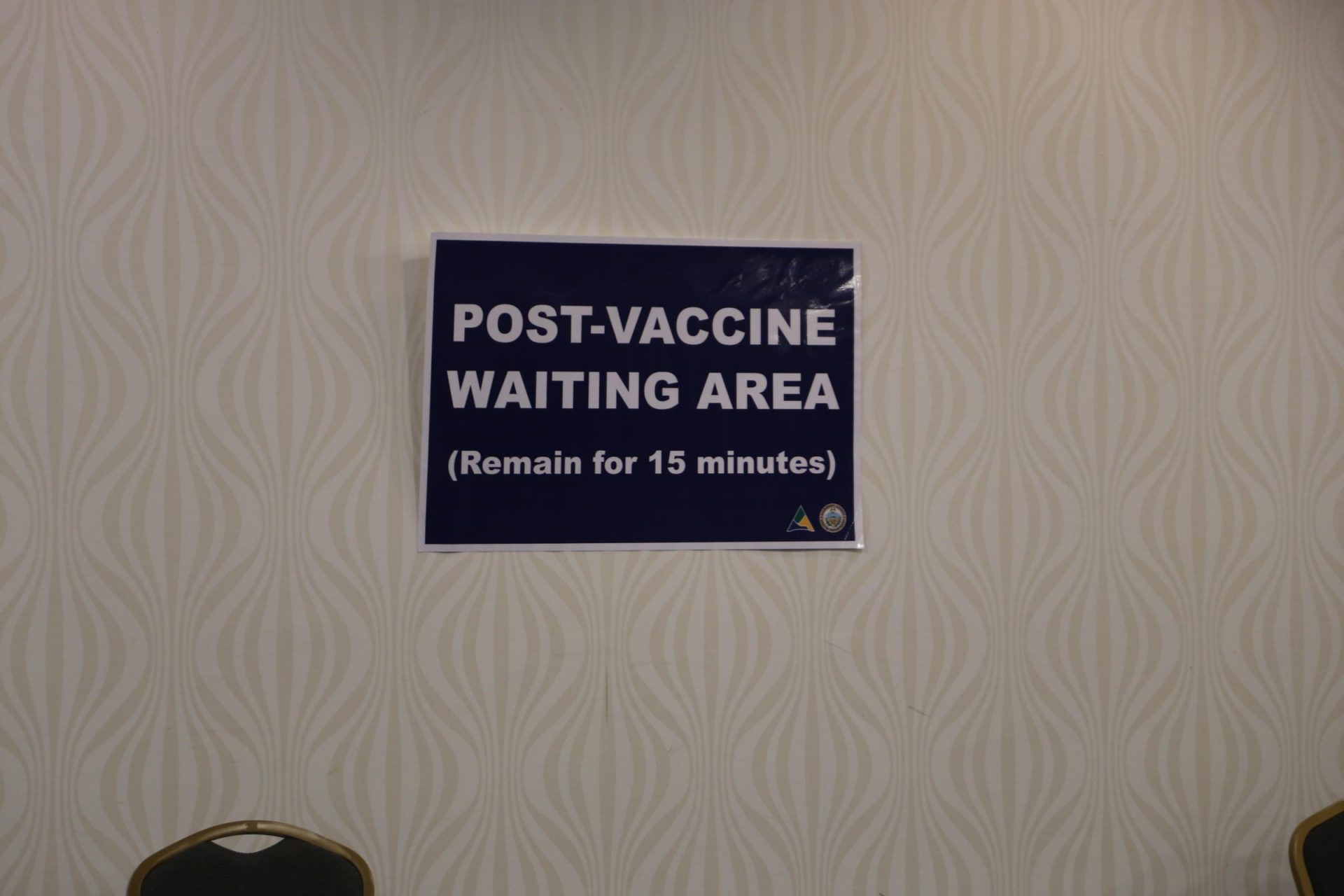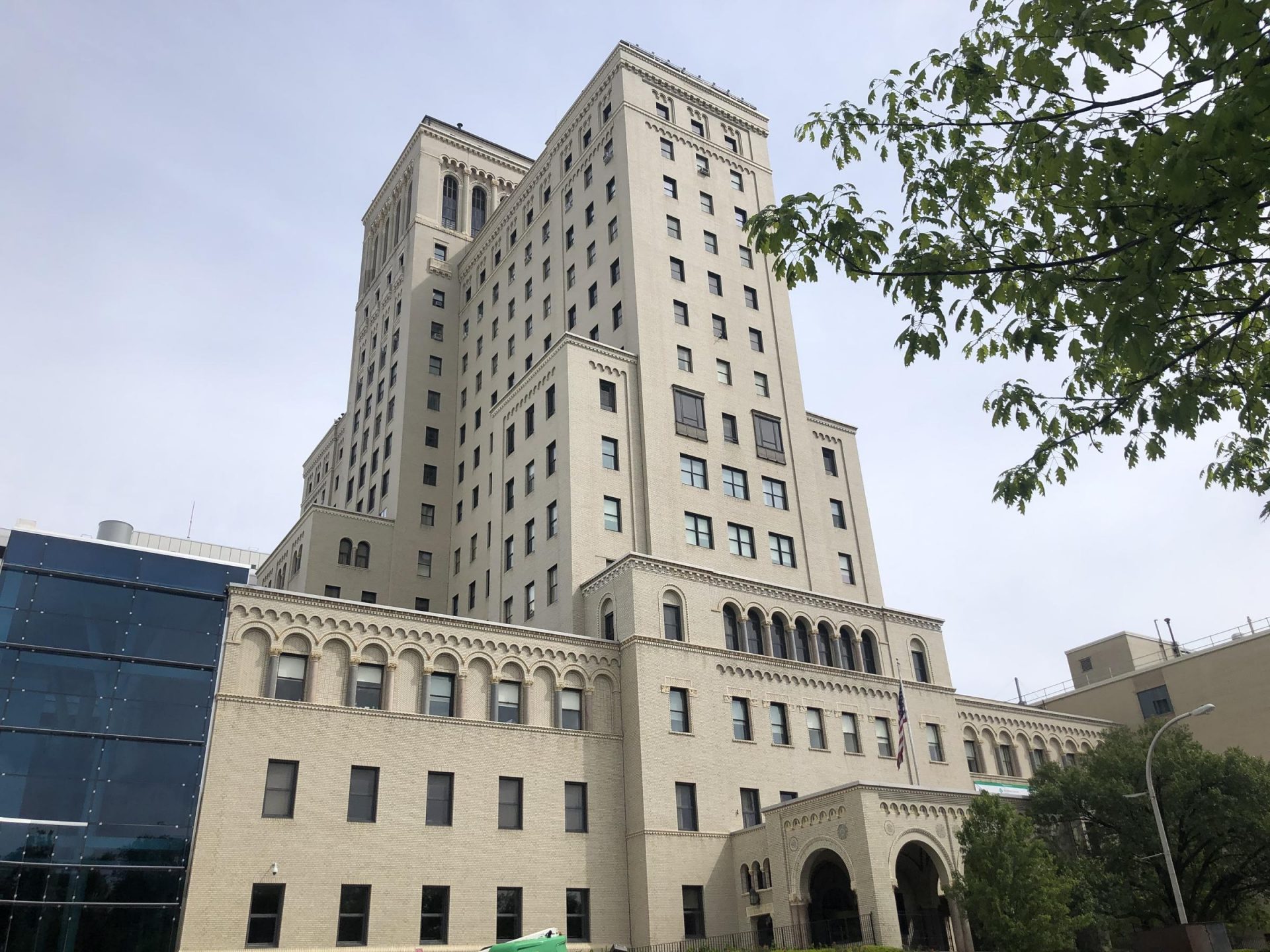
Health care workers socialize on the lawn outside UPMC Presbyterian Hospital in Pittsburgh.
Katie Blackley / WESA

Health care workers socialize on the lawn outside UPMC Presbyterian Hospital in Pittsburgh.
Katie Blackley / WESA

Katie Blackley / WESA
Health care workers socialize on the lawn outside UPMC Presbyterian Hospital in Pittsburgh.
(Pittsburgh) — When a UPMC service coordinator received notification this month that it was her turn to get the COVID vaccine, she was surprised.
The service coordinator said she recalled thinking, “This is really weird,” as she has been working from home since the start of the pandemic.
This UPMC employee, who is in her 30s and has no underlying health conditions, said she first inquired whether her colleagues in sanitation, transportation and food service were also being offered the vaccine.
“They couldn’t give me any specific information, and I was just like, ‘I’m just going to get it, because it will keep my family safe,’” she said. “But I feel really bad about it.”
WESA spoke to more than a dozen clinicians and employees across UPMC departments about the medical system’s vaccination rollout on the condition of anonymity, as these individuals fear retribution by the state’s largest health care system and non-governmental employer. They say UPMC has been vaccinating non-clinical and non-patient facing staff, including those who work at home.
A fundraising employee, also in her 30s who mostly works from home, said she understands why some people will be angry to learn that she got vaccinated so early.
“I’m angry, too,” she said. “I wish I could have had my parents get the shot instead of me.”
Under state and federal guidelines, health care workers are classified as being in “Phase 1A,” making them eligible for the very first round of vaccine distribution. By the state’s definition, a health care employee can include, “but is not limited to,” someone who is not directly involved in patient care but could be “potentially exposed to infectious material that can transmit disease among or from health care personnel and patients.”

Keith Srakocic / AP Photo
The UPMC building in downtown Pittsburgh.
It appears that UPMC has interpreted this guideline broadly, thereby leveraging its position as one of the state’s largest vaccine distributors to put its employees at the front of the immunization line.
The medical system said Tuesday it had administered the first dose of the COVID vaccine to some 41,700 employees, and that 475 residents of skilled nursing facilities have received the inoculation – -which amounts to roughly half of this population. Of its 27 long-term care facilities, UPMC says 10 have yet to get the vaccine.
“The guidance and direction that we’ve been provided by the state and the federal officials were focused on vaccinating employees within health systems and hospitals,” said UPMC chief quality control officer Tami Minnier at a Tuesday press conference. “[We] feel very confident that we are meeting the intent of all of those regulations.”
Sources tell WESA that this approach has led to researchers who almost never set foot in medical facilities, communications and administrative staff, and others who are far removed from clinical settings to receive vaccinations before front-line clinicians of smaller, unaffiliated organizations.
“I am a healthy person. I don’t interact with patients,” said the fundraising employee, who told WESA that she knows of non-UPMC nurses who have yet to get vaccinated.
The Pennsylvania Department of Health’s COVID press secretary, Barry Ciccocioppo, said state officials will reach out to remind organizations that have received vaccine doses that, “their priority should currently be on vaccinating health care workers and high-risk people living and working in long-term care facilities.”
The Pennsylvania Department of Health attempted to level the playing field with a Dec. 30 order which instructed hospitals and other facilities that had received vaccines to reserve at least 10% of inoculations for unaffiliated medical providers.
Despite this directive, medical providers not affiliated with UPMC or Allegheny Health Network are struggling to access vaccinations.

Katie Blackley / WESA
A sign marks the waiting area for people who received a COVID-19 vaccine. The 15-minute waiting period is a precaution because some people who received initial doses of the vaccine developed allergic reactions.
Nick Miller, an American Sign Language Interpreter, spends most of his days in UPMC facilities accompanying deaf patients to their procedures and appointments. Because he is contracted by an interpreting agency and not UPMC itself, Miller was initially unsure whether or not he qualifies to get vaccinated through UPMC.
“We are stuck in a gray area, being essential for communication access and literally right there with the patients and doctors, but [we] have no advocacy when it comes to looking out for us in times such as this,” he said.
Michelle Baird, a Cranberry Township dentist, took a different approach than Miller. She and her colleagues used a list of hospital provider names provided by the state and started making calls.
“I would Google [search] the hospital and whatever phone number came up I would call that number. Often the person that answered wouldn’t have any idea what to do with me,” said Baird.
The list from the state did not include contact information or instructions about how to get in touch with a hospital regarding its reserved vaccine doses. The state has since created a map of vaccine providers which includes some of that information.
Eventually, another dentist at Baird’s practice connected with a hospital and scheduled to get the whole office vaccinated. But to Baird, scoring an appointment felt more like luck and less like a step in a functional vaccination process.
Similar patterns are playing out at hospitals across the country.
“It’s not really in [hospitals’] financial interest to do the work of reaching the highest priority groups,” said Lindsay Wiley, director of the Health Law and Policy Program at American University in D.C.
Wiley said this is partly because medical systems have not received funding to conduct outreach.
“It’s what you get when [the federal vaccination] plan amounts to dumping doses at hospitals and counting on them, left to their own devices, to vaccinate as quickly as possible,” said Wiley. “They’re going to do what’s most convenient to them.”
Last week, UPMC published a form which frontline health care workers can use to request a COVID-19 vaccine appointment. UPMC’s Tami Minnier said the medical system expects to begin inoculating workers who applied through that system later this week.
“We’re prioritizing non-UPMC frontline health care workers who serve under-resourced communities so this limited vaccine can make the biggest impact in those areas,” Minnier said. She did not specify what criteria qualifies an area as under-resourced.
The health system declined to clarify how specific occupations would be prioritized through the online request system. Minnier said Tuesday UPMC would focus on police officers, firefighters and emergency medical service workers. But where workers like dentists or home health aides fall on the priority list is still unclear.
Minnier said Tuesday the system had vaccinated about 2,300 non-hospital employees. AHN told WESA that it has administered 18,000 doses of the vaccine to its staff and unaffiliated frontline health care workers in total; AHN did not specify how many unaffiliated workers it has inoculated.

Katie Blackley / WESA
Allegheny General Hospital in Pittsburgh.
Despite UPMC’s broad interpretation of vaccine eligibility, there is one group of medical personnel working within its facilities who have yet to receive the inoculations.
Sources said most University of Pittsburgh medical students working within UPMC have not been given vaccinations, even though state guidelines include “health professions students and trainees” within the 1A phase.
A group of six third-year medical students told WESA that last week UPMC held a town hall meeting with the medical school to address this lack of vaccines — the tone of which the students described as contentious and condescending.
The day after the meeting, Pitt Medical School Dean Anantha Shekhar announced UPMC would start inoculating medical students, but cautioned this would “take time” given the limited supply of vaccines. Students, who are afraid to speak publicly against UPMC, told WESA they have not been provided a timeline as to when this will be accomplished.
“No one is asking to skip a line, no one is asking to move up in the line,” said one student. “We’re just asking to be put in it.”
Because they spend five or six days a week in the hospital, working shifts that sometimes last 14 hours, students argue that it’s in the interest of patient health to vaccinate them.
“We do not want to get people sick,” said another student.
UPMC has offered contradictory messages about the risk employees of getting or spreading COVID while at work.
Due to its infection-control protocols, UPMC said hospital staff are unlikely to contract the virus in clinical settings. It said the vaccine is necessary to protect its workforce from coronavirus exposures when they are out in the community. Keeping employees healthy is essential to hospital operations.
“We kept people very well protected for the past 10 months, given our plans and PPE. We’ve had virtually very few people develop any symptoms or positive COVID illness,” said Dr. Donald Yealy at the Tuesday press conference. “[The need to vaccinate is] to make sure that initially the entire health care workforce still can do the things that are important.”
Moments earlier, Yealy’s colleague Tami Minnier said employees do present some infection risk while in the hospital. She used the example of an information technology worker, who may work partially at home and partially inside a hospital.
”IT employees at UPMC are present throughout our hospitals,” she said. “They interact with our clinicians side by side, placing our clinicians at risk.”
In response to an inquiry about UPMC’s vaccination rollout, the state health department’s Ciccocioppo noted that focusing first on health care workers will “maximize the benefits of the vaccine.”
UPMC did not directly answer why it prioritized non-clinical employees who work from home over medical students. But it did note that it recently began vaccinating students.
But students who spoke to WESA say, as of Jan. 11, they know of no medical student who has been vaccinated by UPMC. Instead they and many classmates — who sometimes spend 60 or more hours a week inside UPMC facilities — have gone to VA hospitals, local pharmacies and community health centers to get vaccinated.
Throughout the pandemic, America’s skeletal public health system has deferred to hospitals to do the heavy lifting of testing and health guidance messaging. These duties are often administered by government entities in countries where public health is better funded.
American University’s Lindsay Wiley warns that just as health systems were the gatekeepers for COVID tests during the first months of the pandemic, getting the vaccine might also become a bureaucratic maze—especially as the groups eligible for vaccination become broader.
“These hospitals who have the most resources … what do they owe to patients in their own community who are not already connected to that hospital?” she said.
Wiley said the discretionary distribution of the vaccine by UPMC and other health care systems was the predictable outcome after the U.S. Senate held up funding for vaccine distribution. She pointed out that back in early June, organizations like the National Association of City and County Health Officials were “sounding the alarm.”
“Not only did the Senate delay,” she said, “[but] it sort of strung the states along [with funding.]”
Congress finally funded vaccine distribution at the end of December. Now the concern is how quickly federal agencies will distribute this money to local public health departments — which could then mobilize vaccination campaigns to populations with the highest levels of need.
“We have to kind of get out of the kind of individualistic head space of where we’re thinking about injustices of this specific woman who works in fundraising who got a vaccine,” said Wiley.
Instead, she said, the focus needs to be on how to quickly reach those who most desperately need vaccinations, and not worry about the people who might luck into shots along the way.
The days of journalism’s one-way street of simply producing stories for the public have long been over. Now, it’s time to find better ways to interact with you and ensure we meet your high standards of what a credible media organization should be.